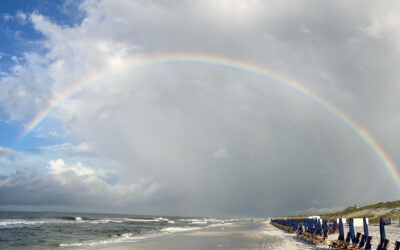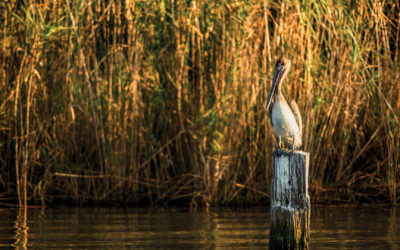the story of the emerald coast’s white sand
From the mountains to the beach

“It’s this perfect maritime world that
stretches on for miles and miles
in either direction.”
The sand. Flour-soft and, on sunny days, blindingly white. It’s a defining presence on Florida’s Emerald Coast, changing everything it touches—from the water itself to those who visit the coastline it forms.
This soft powder is actually rock—nearly 100% quartz mixed with finely ground seashells. Together they form a seabed that stretches miles out into the Gulf of Mexico. Wave action on the Gulf slowly develops submerged sandbars that run along the length of the coastline. In the shallows, the water appears to glow as though lit from within—the effect of refracted sunlight reflecting off the seafloor. This combination of sun, sea, and sand creates stunning gradations of color from white to aquamarine to cobalt blue.
A casual walk on an Emerald Coast beach is a sensory experience. The sand is so pure that it squeaks underfoot. Listerine-colored waters are paired with the tactile sense of impossibly soft and utterly homogenous sand. The wetted portions form a slurry that is at once soft and abrasive, something to be played in or shaped into sculpture. It’s this perfect maritime world that stretches on for miles and miles in either direction. There are other beaches further to the east and west, but nothing approaches the otherworldly allure of the Emerald Coast.
ORIGINS
So, where does the sand come from? And why does every other beach in the world pale in comparison?
The beaches of the Emerald Coast are made from the stuff of mountains—specifically the Appalachians. The story begins 12,000 years ago in the final centuries of the last ice age when the planet was warming, and the miles-deep North American ice sheet was in full retreat. Along the spine of the Appalachians, the ice and rock beneath it formed what can only be described as a massive crucible that pulverized the quartz into a fine talc-like powder (under a microscope, the individual grains are finely worn into ovals—like tiny identical bits of sea glass). The melting ice became a torrent, sending a slurry down various waterways all the way to the Gulf of Mexico, much of it delivered by what we now know as the Apalachicola River. Upon arrival at the coast, tides and currents sent the powdered quartz in every direction—but mostly eastward. As the millennia came and went, a wholly unique coastline formed.
CLARITY
Why are the waters of the Emerald Coast so luminous and clear? The short answer: The absence of pollution—especially when compared to the coastal waters west of the Mississippi. There are reasons for this. First, Florida is the only Gulf state that doesn’t allow offshore drilling, an industry that comes with the accompanying infrastructure of rigs, refiners, and pipelines. The absence of this infrastructure means far less oily sludge finding its way to Florida beaches. A continuing 10-year moratorium, renewed in September of 2020, is presently in place and enjoys overwhelming support among Floridians, many of whom depend on tourism for their livelihood. In 2019, Florida welcomed 145.4 million out-of-state visitors who spent $98.8 billion, supporting 1.6 million jobs. One of the biggest draws for those visitors is the pristine beaches and coastal waters.
The Emerald Coast also owes a debt of gratitude to the Mississippi River. The river’s outflow is situated about 100 miles southeast of New Orleans. It comes rushing through southern Louisiana, heading southeast before making a hard turn to the west- southwest. It makes this turn just before it spills into the Gulf, sending its cargo of sediment, mud, and runoff away from Florida. There are no major river outflows east of the Mississippi, and therefore far less sediment in the northeastern Gulf.
The white sand beaches of northwest Florida extend westward as far as Cape San Blas and as far east as Pensacola near the Alabama/Florida border. Some of the sand, however, has migrated to the southeast, finding its way to the beaches between St. Petersburg and Marco Island.

ONGOING PHENOMENA
The story of our soft, white sand, and the beaches that bring millions of visitors to the Emerald Coast each year, is still in the making. The Appalachian Mountains, worn by the constant flow of water, continue to release its buried veins of quartz. And in every moment of every day, the Apalachicola River delivers that small, precious cargo to the sea.
PROTECTION
Another ongoing phenomenon: The protection
of Florida’s beaches and coastal waters. The current offshore drilling moratorium is temporary. It expires in 2030. Which begs the question: How durable is the will to protect
the destination we love?
Visit https://healthygulf.org to learn how you can help protect Florida’s Emerald Coast.
Recent Stories
Explore and discover all of the Emerald coast.
Sandcastle Kids: Healing Hearts
Sandcastle Kids, a South Walton 501c3 nonprofit, carries out their healing mission by providing all-expenses-paid vacations to families experiencing a diagnosis of childhood cancer. As you can imagine, these families undergo tremendous mental, emotional, and financial...
The Secret History of Eastern Choctawhatchee Bay
There’s an odd cluster of pilings on the eastern edge of the Choctawhatchee Bay. Ever noticed them when driving north across the bridge? These aren’t the remains of an ill-fated attempt at a bridge, but are part of a system capable of detecting low-flying aircraft...
Serving in Seaside for 23 Years and Counting
Bartender Mo Mosely has been greeting patrons and slinging drinks at Bud and Alley’s rooftop bar for 23 years (and counting). Back before Scenic 30A was the bustling, year-round destination that it is today, Bud and Alley’s was the only bar on 30A open late into the...



